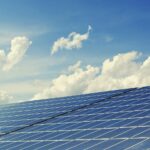Hybrid solar plant
Hybrid solar plant uses photovoltaic cells together with heat tubes, improving efficiency by 15%
It would seem that the more sunlight that hits a solar panel, the better it will perform. But if you approach the question from an efficiency standpoint, this is far from the case, because as photovoltaic cells get hotter, their performance decreases. In order to put the heat from heated panels to good use, a team of British scientists from Brunel University has developed a hybrid system that can turn a home’s roof into an efficient solar generator.
The system can cool solar panels and produce hot water
The London-based engineers’ patented innovation combines photovoltaic cells and heat pipes to produce both electricity and hot water. Heat pipes are elements of cooling or heating systems made of metal with good thermal conductivity, the principle of operation of which is to transfer heat from its surface to the liquid coolant (water, freon, etc.). They are widely used in a variety of modern technology: air conditioning systems, computers, in powerful LED lamps, as well as in space equipment.
“Nowadays, the roofs of houses have to be specially arranged to dissipate the heat from the solar panels that get very hot in summer,” says Dr. Hussam Jouhara, a heat-tube specialist and head of the project. – Simply insulating the house beneath the panels is not the answer, because it will cause the solar cells to heat up even more and reduce their efficiency.
Dr. Hussam Jouhara
The new solar plant uses planar tubes that are housed in 4 x 400 mm photovoltaic modules, whose shape allows for optimized collection of solar radiation. These tubes transfer the heat from the solar cells to the water, which drains it and can be used for hot water or heating, among other things.
At the same time, the efficiency of solar panel power generation increases significantly: in tests, scientists achieved a 15 percent improvement in the performance of their hybrid system compared to traditional installations.
Dr. Johara says the scientists noted some amazing capabilities of the system: “Our flat heat pipes are so efficient, they have the ability to ‘harvest’ energy from the morning dew evaporating from the roof where the tests are conducted.
Another advantage of flat heat pipes is their easy installation on solar panels. The modules in which they are encased are assembled as easily as laminate floors and are equipped with protection against the effects of bad weather. A prototype hybrid solar system is now being tested on a standard three-bedroom apartment building at the research base in Watford.









